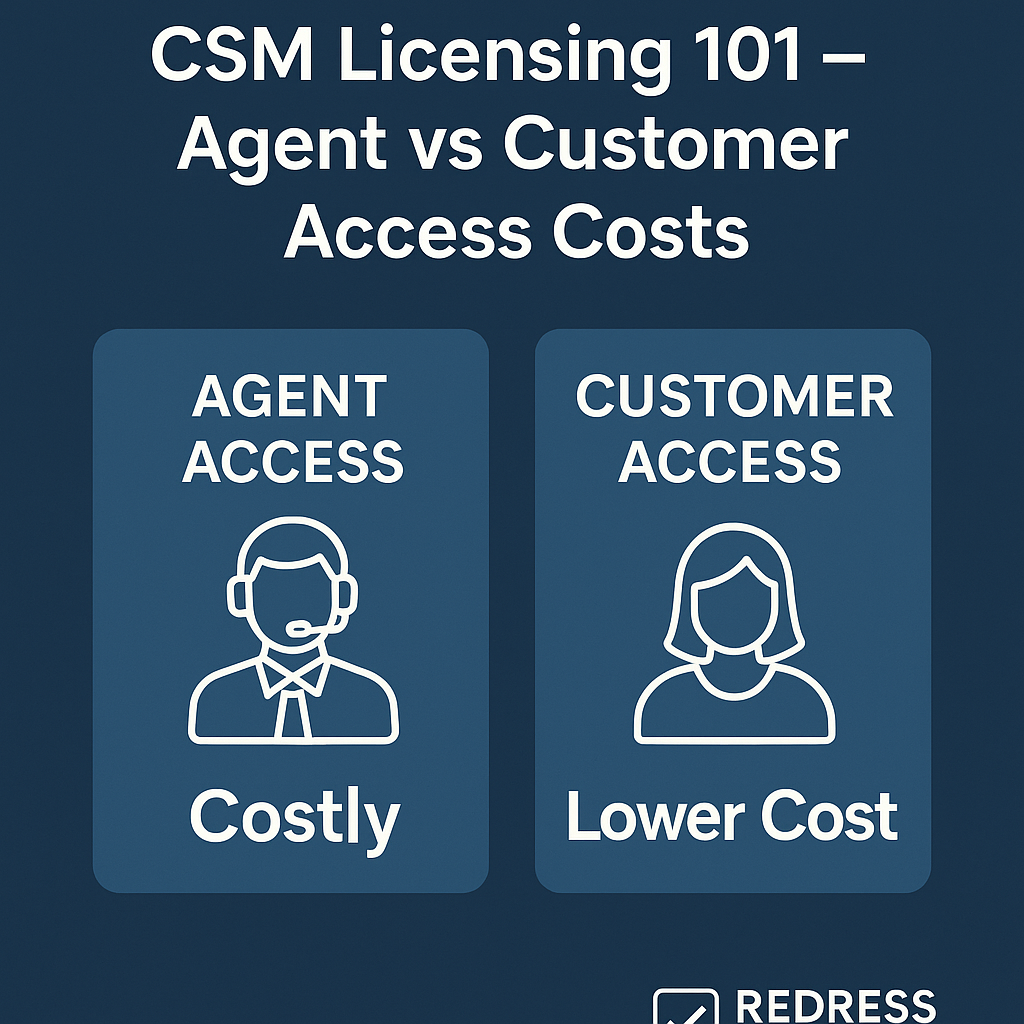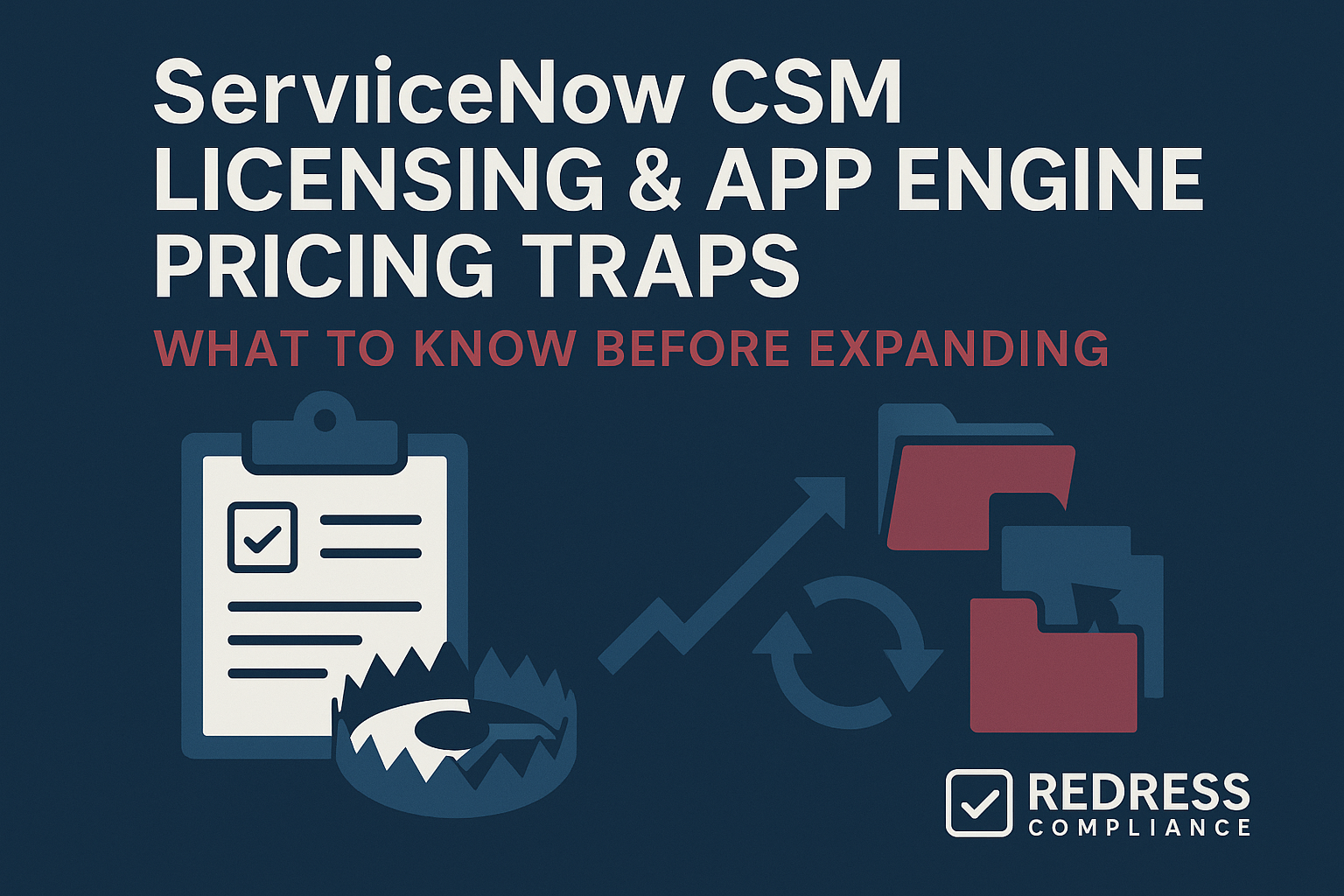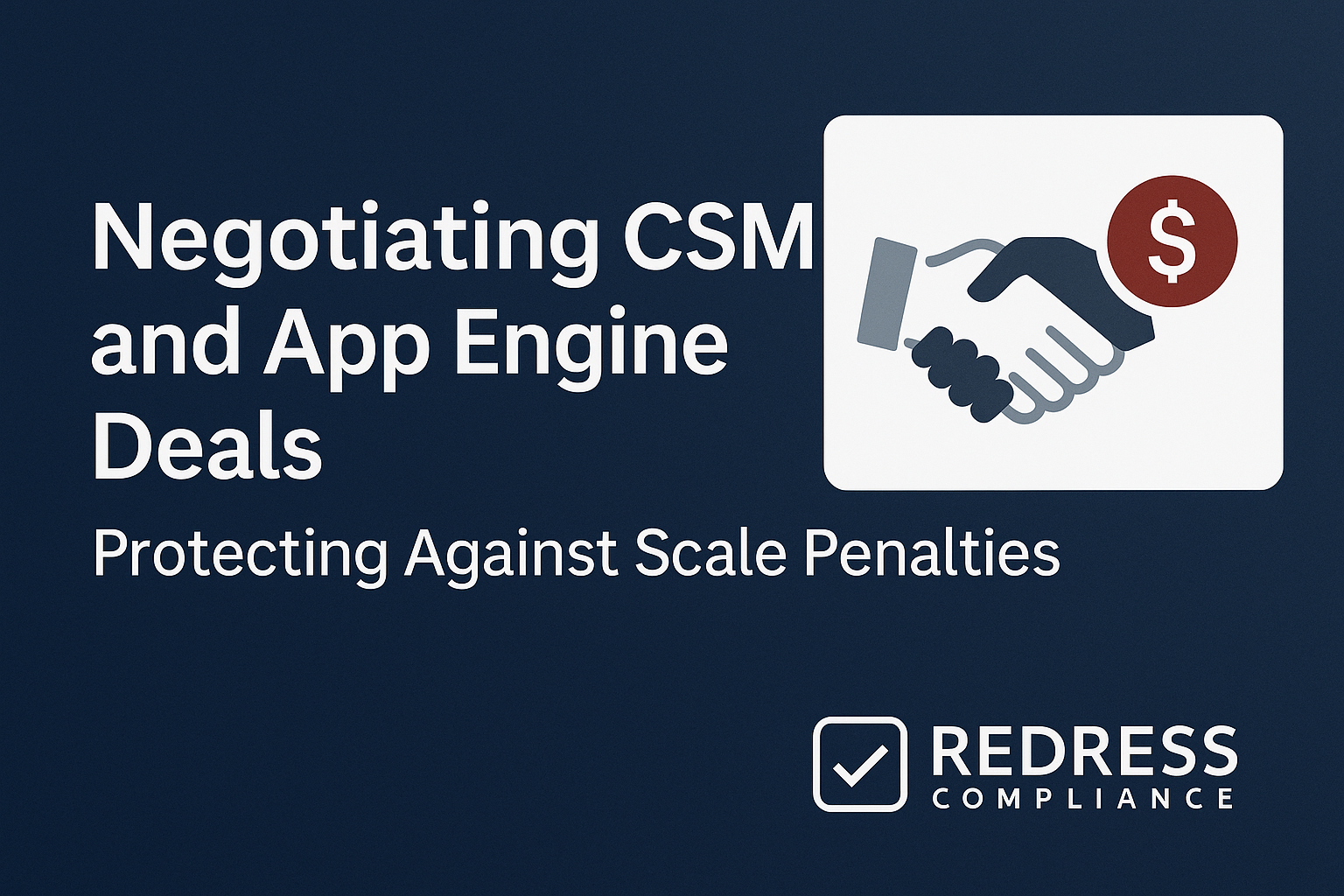ServiceNow CSM Licensing – Agent vs Customer Access Costs Explained
Licensing for ServiceNow’s Customer Service Management (CSM) works differently from licensing for IT Service Management (ITSM). The CSM license model shifts focus from internal IT users to external-facing support agents. In CSM, you pay for your support agents (fulfiller users who handle customer cases), while customer access is typically free.
In other words, your costs depend mainly on how many agent licenses you need and which edition and add-ons you choose – not on how many customers you support. Read our ultimate guide to ServiceNow CSM Licensing & App Engine Pricing Traps: What to Know Before Expanding.
CSM licenses tend to cost more per user than ITSM licenses, reflecting the higher value of customer-facing work. Therefore, it’s critical to understand all the cost drivers and right-size your licensing to avoid overpaying.
Why CSM Licensing Feels Different from ITSM
ServiceNow CSM extends ITSM concepts to external customer support, and that changes the licensing equation. In ITSM, licenses cover internal employees and their IT tickets. With CSM, the focus moves to external-facing roles and their customer cases:
- External support focus: CSM licenses are mostly for agents who assist your paying customers (unlike ITSM, which serves internal staff).
- “Fulfiller” = CSM agent: CSMs still use named fulfiller licenses, and each support agent working on customer cases needs their own license (often called a CSM agent license).
- Higher-value use case: Since serving customers is business-critical, ServiceNow prices CSM agent licenses at a premium. CSM licenses cost more because they serve paying customers, which ServiceNow sees as higher value. (Expect CSM agent licenses to cost noticeably more than ITSM fulfiller licenses.)
Pro Tip: “CSM licenses cost more because they serve paying customers — ServiceNow treats that as a higher-value use case.”
Agent Licensing – The Real Cost Driver
The number of CSM agent licenses you require is the biggest factor in CSM costs.
Each customer service agent who works on cases needs a license, and those licenses carry premium pricing:
- Who counts as an agent: Anyone resolving external customer cases in ServiceNow (support reps, etc.) needs a CSM agent license.
- Per-user, premium pricing: CSM agent licenses are sold per named user (no concurrent sharing) and often cost 30–40% more per user than an ITSM license. You pay extra for each agent because of the added customer service capabilities and value.
- Edition tiers: CSM is offered in Standard, Professional, and Enterprise editions. Higher tiers unlock more features (analytics, virtual agent chatbot, AI, digital channels) and come with higher per-user costs.
Mini-scenario: A telecom firm doubled its support team from 25 to 50 agents. Their annual CSM licensing cost didn’t just double – it jumped 38%. Adding 25 more users at the higher CSM rate (and moving into a higher edition tier for additional features) drove the spend up substantially.
Pro Tip: “Negotiate a tiered or banded agent model — pay less per user as your team scales.” For example, arrange volume pricing (say, the first 20 agents at full price, the next 30 at a lower rate) so that as you add agents, the average cost per agent goes down.
Customer Access – Free but Indirectly Costly
One big difference with CSM is that you don’t pay for each customer who uses your support portal or emails – those end-users do not need licenses. However, supporting lots of customers can still incur indirect costs in other ways:
- Unlimited customer users: You can have thousands or even millions of external customers submitting cases without needing individual licenses. ServiceNow allows unlimited customer/self-service accounts for free.
- Usage-driven costs: If customer activity surges, it can require more ServiceNow resources. Large volumes of cases, chats, or API calls may force you to purchase extra capacity – for example, additional storage, more Integration Hub transactions, or a higher instance tier to maintain performance.
Mini-scenario: A retail company’s CSM usage spiked during a holiday season. They didn’t pay per customer who submitted issues, but they did have to buy extra Integration Hub capacity to handle a flood of API calls to their order system. The customers were free; handling their volume had a cost.
Pro Tip: “Ask ServiceNow what non-agent costs might scale with customer activity — integration, case storage, or AI chat volume.” Identify potential usage-based costs (like integration transactions or virtual agent sessions) up front so you can avoid surprise fees as your customer base grows.
CSM Editions and Add-Ons – What You’re Really Paying For
ServiceNow offers CSM in different editions, and some add-ons can affect your total price. Knowing what’s included versus extra will clarify where your budget is going:
- Standard: Basic CSM package – case management, customer portal, and knowledge base. It covers core support needs with no advanced automation.
- Professional: Adds a Virtual Agent chatbot, customer service analytics, and integration capabilities. This mid-tier is a common choice for companies that need more than the basics.
- Enterprise: Everything in Pro plus advanced AI features (like AI-driven case deflection and predictive routing). Priced higher for organizations that plan to leverage AI at scale.
- Add-ons: Optional modules like Digital Engagement (additional chat/SMS channels) or industry-specific CSM packs (for Telecom, Finance, etc.) are sold separately. These can add roughly 25–35% to your total CSM costs if you include them.
Pro Tip: “Most organizations start with Professional — Enterprise only pays off if you’re deploying large-scale AI.” Don’t jump to the Enterprise tier unless you have a clear plan to use those AI capabilities. Many teams get great value from CSM Professional plus a couple of targeted add-ons.
Read how to manage CSM expansions, CSM Expansion Traps – How Growing Customer Volume Impacts Costs.
Common Pricing Pitfalls (and How to Avoid Them)
Even savvy buyers can run into licensing pitfalls. Here are common CSM pricing mistakes, their impact, and how to avoid them:
| Pitfall | What Happens | Cost Impact | How to Avoid |
|---|---|---|---|
| Assuming ITSM covers CSM | Thinking ITSM licenses let agents handle customer cases – they don’t. CSM requires its own agent licenses. | High | Plan for separate CSM licenses early. Don’t rely on ITSM licenses for external support. |
| Buying too many agents upfront | Purchasing more CSM licenses than you use initially (licenses sit idle). | Medium | Start with the minimum needed. Add licenses gradually as your team and workload grow. |
| Ignoring necessary add-ons | Not budgeting for extras like Digital Engagement or industry modules, leading to an unplanned cost jump later. | High | Identify needed add-ons from the start. Negotiate them into your agreement so you’re not surprised at renewal. |
| Double-licensing hybrid agents | Giving one person both an ITSM and a CSM license because they work on internal and customer issues (paying double). | High | Align roles to one SKU. If someone handles customer cases, give them a CSM license (covers ITSM tasks too) instead of two separate licenses. |
| Volume/automation overages | Heavy use of integrations, API calls, or AI (high customer volume) incurs fees beyond base entitlements. | Medium | Negotiate or cap these in your contract. For example, include a buffer of Integration Hub transactions for peak volumes to avoid overages. |
Pro Tip: “Clarify licensing for hybrid roles — one user acting as both ITSM and CSM agent shouldn’t double-count.” Ensure a single person isn’t accidentally licensed twice. Usually, a CSM license lets that user handle ITSM work too, so use one license that covers all their duties.
Structuring a Cost-Effective CSM Deal
When planning your CSM purchase, take a strategic approach to get the best value:
- Start with a pilot scope: Define an initial rollout (a limited number of agents, channels, and cases) and buy licenses just for that. Prove value on a small scale, then expand with more licenses as needed.
- Negotiate volume discounts: Work with ServiceNow on tiered pricing for agents. For example, the first 25 agents are at full price, and the next 25 are at 10% off. This way, your average cost per agent drops as your team grows.
- Include expansion protections: Ensure your contract lets you add more licenses later at the same discounted rate. Expansion clauses (or “price holds”) lock in your pricing so you won’t pay a premium when you scale up or add new features.
Mini-scenario: A global manufacturer started with 15 CSM agents but anticipated needing 50+ within 18 months. By pre-committing to that growth during negotiations, they secured a 20% lower price on all additional CSM licenses. This gave them predictable costs for scaling their team, and ServiceNow was happy to lock in a larger deployment.
Pro Tip: “Don’t just negotiate price per seat — tie pricing to value metrics like case volume or SLA improvement.” For example, if you expect to handle 10,000 customer cases a month, use that in discussions. Structure the deal so pricing reflects hitting certain volume or service targets, ensuring you pay for results, not just headcount.
CSM vs ITSM Licensing – A Quick Comparison
| Aspect | ITSM Licensing | CSM Licensing |
|---|---|---|
| Primary License Metric | Fulfiller user (IT agent) | Agent user (customer service agent) |
| External Users | Employees only (internal) | Customers via portal (no license) |
| Relative Cost | $$ (baseline per user) | $$$ (about 30–40% higher per user than ITSM) |
| Typical Add-ons | Incident, Change, Problem (core ITSM processes) | Digital Engagement channels, industry-specific modules |
| Integration Needs | Internal systems (IT tools) | External systems (CRM, ERP, etc.) |
Pro Tip: “If your ITSM team already serves internal users well, extend cautiously into CSM — costs grow faster than expected.” Customer service brings a lot of value, but make sure to budget for how quickly agent counts and usage can grow. Expand in phases and monitor ROI, since the per-agent costs in CSM are higher.
5 Insightful Next Steps for Buyers
If you’re evaluating ServiceNow CSM licensing, consider these next steps:
- Audit your support team: Determine who would actually be CSM agents. Identify how many people currently handle external customer issues. This avoids overestimating licenses by counting staff who won’t need the CSM platform.
- Forecast customer case volume: Estimate how many customer inquiries (tickets, chats, calls) you expect per month. If you anticipate high volumes, note potential extra needs (integration capacity, AI usage) and factor those into your plan.
- Choose the right edition: Align the CSM tier to your needs. If you only need basic case tracking, Standard might suffice. If you want chatbots or analytics, consider the Professional plan. Enterprise only makes sense if you have a plan to utilize its AI features. Don’t overpay for features you won’t leverage.
- Ask about discounts and protections: Discuss volume pricing and growth protections with ServiceNow or your vendor. Ensure that if you add more agents next year, they’ll be at the same rate you negotiate now. Locking in pricing for expected growth will protect your budget.
- Review ITSM vs CSM user roles: Make sure individuals aren’t double-licensed. If some team members handle both IT and customer support, decide on a single license (usually CSM) that covers both. Proper role mapping prevents buying two licenses for one person.
By following these steps, you can craft a ServiceNow CSM licensing agreement that fits your organization’s needs and delivers great customer service without overspending on licenses.
Read about our ServiceNow Advisory Services.


